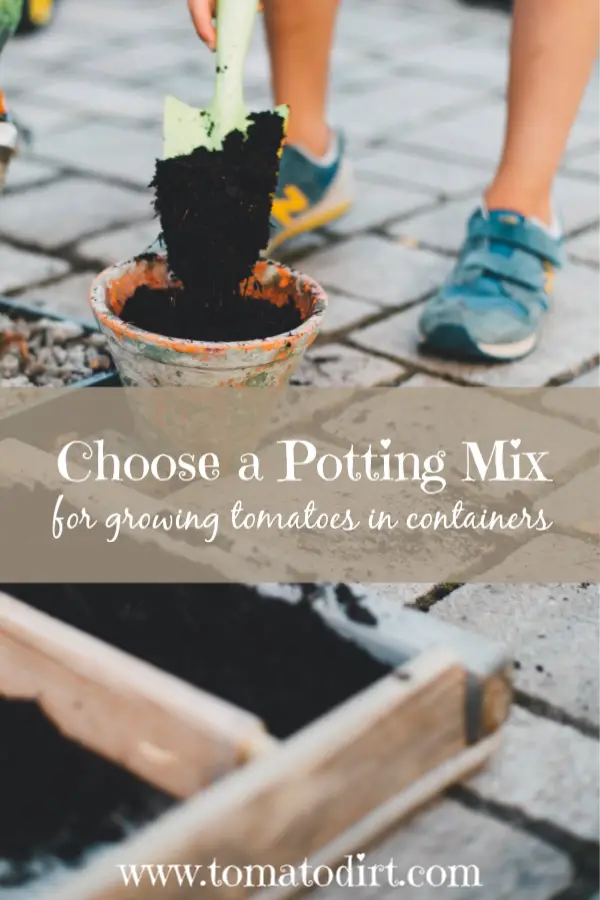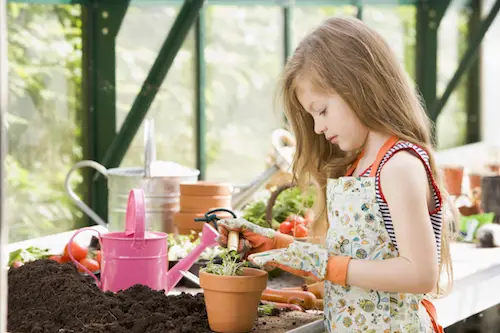“What potting mix should I use for growing tomatoes in pots or containers?”
Since 2010, Tomato Dirt has garnered 4.6+ million views, making it the web’s leading online source for growing tomatoes in the home garden. Award-winning writer and Tomato Dirt owner Kathy Widenhouse has helped thousands of home gardeners grow healthier tomatoes. Be one of them when you get Tomato Dirt’s Growing Guide here.
One of the first steps in growing tomatoes in pots is to pick a good potting mix. You need to fill the pots with a soil medium that works best for container growing.
There are a lot of options to choose from: potting soil, potting mix, topsoil … even soil straight from the garden.
Growing Tomatoes in Pots: Top Tips
Don’t go super cheap. Tomatoes grown in containers need well-drained soil with lots of organic matter. It can be tempting to load up your containers with soil dug from your backyard or garden – the dirt is free, right?
Don’t use garden soil. It compacts making it difficult to water and keep aerated by mid-season. Also, garden soil is infested with fungi, weed seeds, and pests, which can wreak havoc in your containers, infect your tomato plants, and cost you your crop in the long run.
Don’t go super easy. It may seem to be convenient to pop open a bag of potting soil, pour it into your container, and be done with things. But potting soil can be too heavy for containers – leading to drainage problems.
Tomato Dirt best advice
Fill your container with a good potting mix (rather than potting soil) and wet it slightly. (Some gardeners call this an “artificial medium” or “soil-less mix.”) Potting mix is different than potting soil. Nurseries all over the country use a good mix to start seeds and plant containers. You can find affordable mixes at your local discount store, home improvement store, or local garden center. Or you can make your own - here's how.
How to Choose a Good Mix
Check the ingredients. Good potting mixes contain peat moss, compost, vermiculite, perlite, and sand. The best mix holds moisture but doesn’t stay soggy.
Standard mixes. Designed to sustain the plant but has little fertilizer or extra nutrients added. Some gardeners prefer standard mixes because they are less expensive. If you’re able to stick to your own fertilizing and watering schedule during the growing season, a standard mix could be a good solution for you.
Premium mixes. Includes additions such as fertilizer, wetting agents, and extra water-holding capacity. Premium mixes cost more. Some gardeners find the convenience a plus.
Commercial mixes. Popular brand name soil mixes such as Jiffy Mix®, Bacto®, Promix®, and Jiffy Pro® are available at garden centers.
How to Make a Good Mix
If you’re planting several containers, you can save money by making your own potting mix. Find these ingredients at your local discount or home improvement store or online. For best proportions, mix together 1 part each. Moisten the mix before filling containers for planting.
Potting soil. Usually a mixture of peat, composted materials, sand, perlite, and vermiculite. Some commercial potting soils contain ground limestone (to regulate pH) and others have small amounts of fertilizer or slow-release nutrients. Commercially available potting soil is sterilized, preventing the spread of diseases, pests, fungi, and weeds. Interestingly, most potting soils contain very little soil.
Perlite. Helps prevent water loss and soil compaction
Sphagnum peat moss. Increases soil’s ability to hold water
Compost. Decayed, decomposed, screened organic matter that provide nutrients and helps provide a rich growing medium.
Should you add water holding gels to your mix?
There’s some controversy about adding water holding gels (also called hydrogels, water retention granules, or root watering crystals) to your mix. These gels swell several times their size when hydrated. They then release water slowly over time. The idea is to reduce, or at least balance, the need for watering in containers, gardens, and landscapes. Gels have become increasingly popular with home gardeners.
Yet horticulturalists have discovered that the gels, manufactured as polymers, are biodegradable. They are not a long-term solution to water management. Their breakdown can release potentially damaging byproducts into your soil.
More about Growing Tomatoes in Containers
How to make your own potting mix for growing tomatoes ...
How to grow tomatoes in pots: 14 tips ...
Sterile potting mix: do you need it for growing tomatoes?
Growing tomatoes in pots: the basics ...
Choosing containers for growing tomatoes in pots ...
5 Tips for Planting Tomatoes in Pots: Plan for Success ...
Review: Self-watering tomato planter: Tomato Success Kit ...
Do Container Tomatoes Need Staking?
Tomato bags are sturdy, grow healthy tomatoes ...
Choosing tomato varieties for large containers ...
Best tomato varieties for small containers ...
Tomato planting in pots ...
Tomato fertilizer to use for container tomatoes ...
Watering tomatoes in containers, pots, baskets...
Tomato pests that attack tomatoes in containers ...
Growing cherry tomatoes in containers or pots ...
Tips for growing cherry tomatoes in containers ...
Better Boys in containers: fruit is small, what should I do?
More tips for growing tomatoes in pots on our Pinterest board ...
How to grow hanging tomatoes ...
Return from Potting Mix for Growing Tomatoes in Pots ...
As an Amazon Associate and Rakuten Advertising affiliate I earn from qualifying purchases.
SHARE THIS PAGE:
FREE! 10 Must-Know Tomato Growing Tips: 20-page guide
Get yours here:






New! Comments
Have your say about what you just read! Leave a comment in the box below.